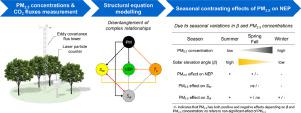Agricultural and Forest Meteorology ( IF 6.2 ) Pub Date : 2022-09-01 , DOI: 10.1016/j.agrformet.2022.109149 Hojin Lee, Jihyeon Jeon, Minsu Lee, Hyun Seok Kim

|
Urban forests are recognized as eco-friendly filters to reduce PM2.5 concentrations. However, there remains a lack of consensus on how PM2.5 affects forests’ productivity in highly polluted urban areas by altering solar radiation components. Here, we tested the hypothesis that the effects of PM2.5 on the solar radiation components and forest productivity differ by season because of seasonal variations in solar elevation angle (β) and PM2.5 concentrations. The PM2.5 concentrations and CO2 fluxes were measured using optical particle counters and an eddy covariance system, respectively, from April 2018 to December 2019 at a natural deciduous oak stand and an evergreen pine plantation in the peri‑urban region of the Seoul Metropolitan Area, Republic of Korea. Complex relationships among PM2.5 concentration, direct radiation (Sdir), diffuse radiation (Sdf), air temperature (Ta), and net ecosystem production (NEP) were disentangled by season and β using structural equation modeling. We found that the Sdf was the controlling factor of NEP in both the stands, showing a more substantial effect than that of Sdir, Ta, and PM2.5. In the oak stand, when oaks hold their leaves (May–October), the increase in PM2.5 concentrations enhanced Sdf and NEP, and it was more significant when β increased from 10 to 20° to > 60° However, in the pine plantation, the increase in PM2.5 concentrations enhanced Sdf and NEP when β > 40° and PM2.5 < 10,100 cm–3. In contrast, when β < 40° and PM2.5 > 10,100 cm–3, PM2.5 increase resulted in a greater Sdir reduction than Sdf enhancement, which consequently led to a NEP reduction. Our study results demonstrated the contrasting seasonal effects of PM2.5 on solar radiation components and forest productivity and highlighted the importance of integrating them into ecosystem modeling and environment management plans in urban or peri‑urban regions.
中文翻译:

PM2.5 对韩国首尔都市区近郊地区森林生产力的季节对比效应
城市森林被认为是降低 PM 2.5浓度的环保过滤器。然而,对于 PM 2.5如何通过改变太阳辐射成分来影响高度污染城市地区的森林生产力,仍然缺乏共识。在这里,我们检验了这样一个假设,即由于太阳仰角 ( β ) 和 PM 2.5浓度的季节性变化,PM 2.5对太阳辐射成分和森林生产力的影响因季节而异。PM 2.5浓度和 CO 2从 2018 年 4 月到 2019 年 12 月,分别使用光学粒子计数器和涡流协方差系统在大韩民国首尔都市区周边地区的天然落叶橡树林和常绿松树种植园测量通量。PM 2.5浓度、直接辐射 ( S dir )、漫射辐射 ( S df )、气温 ( T a ) 和净生态系统产量 (NEP)之间的复杂关系通过季节和β使用结构方程模型解开。我们发现S df是两个林分中 NEP 的控制因素,显示出比S更显着的影响目录、T a和 PM 2.5。在橡树林中,当橡树保持叶子时(5-10 月),PM 2.5浓度的增加增强了S df和 NEP,并且当β从 10 到 20° 增加到 > 60°时更为显着。在人工林中,当β > 40° 且 PM 2.5 < 10,100 cm –3时,PM 2.5浓度的增加会增强S df和 NEP 。相反,当β < 40° 和 PM 2.5 > 10,100 cm –3时,PM 2.5的增加导致更大的S dir减少比S df增强,因此导致 NEP 减少。我们的研究结果证明了 PM 2.5对太阳辐射成分和森林生产力的对比季节性影响,并强调了将它们纳入城市或城市周边地区的生态系统建模和环境管理计划的重要性。


























 京公网安备 11010802027423号
京公网安备 11010802027423号